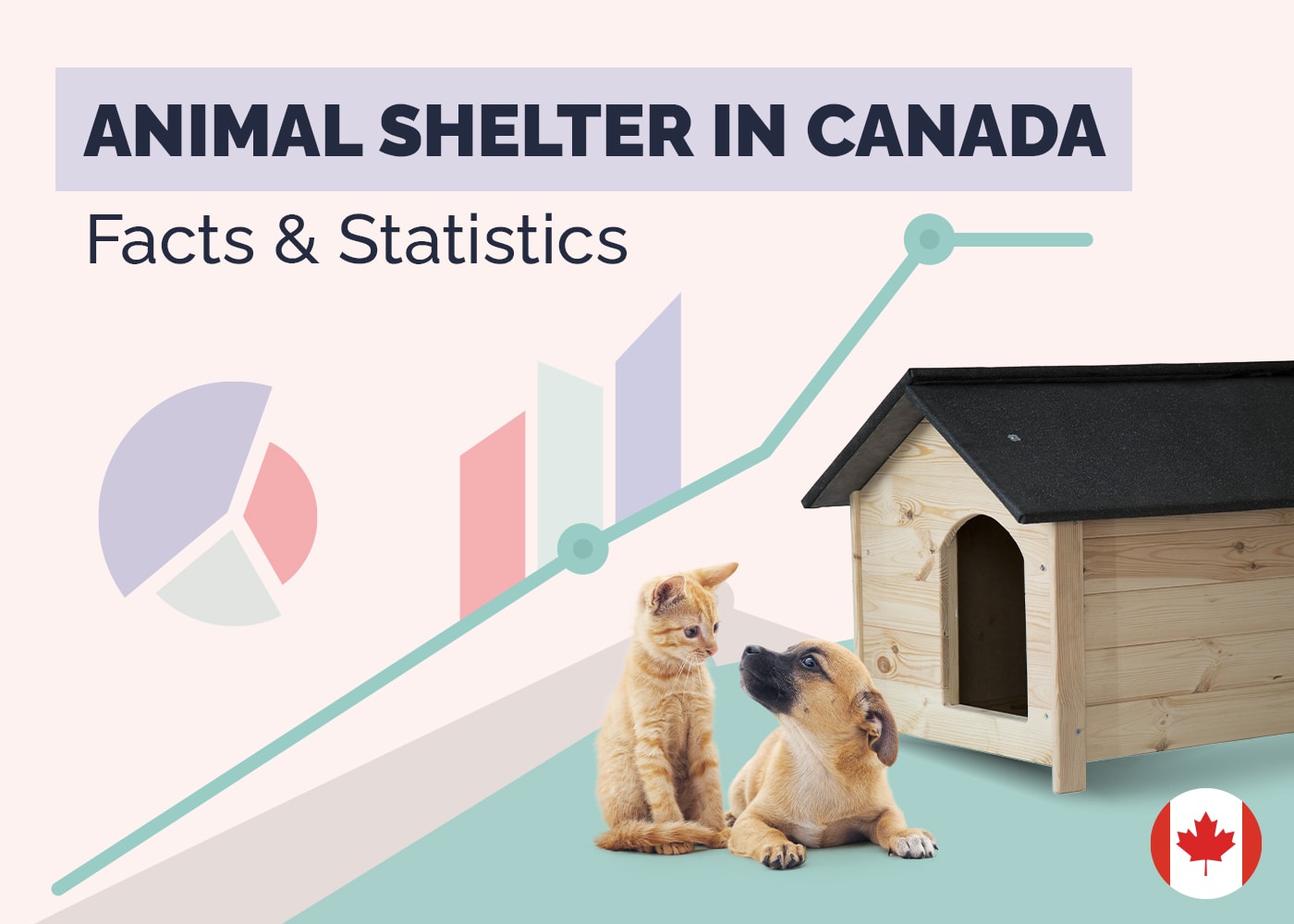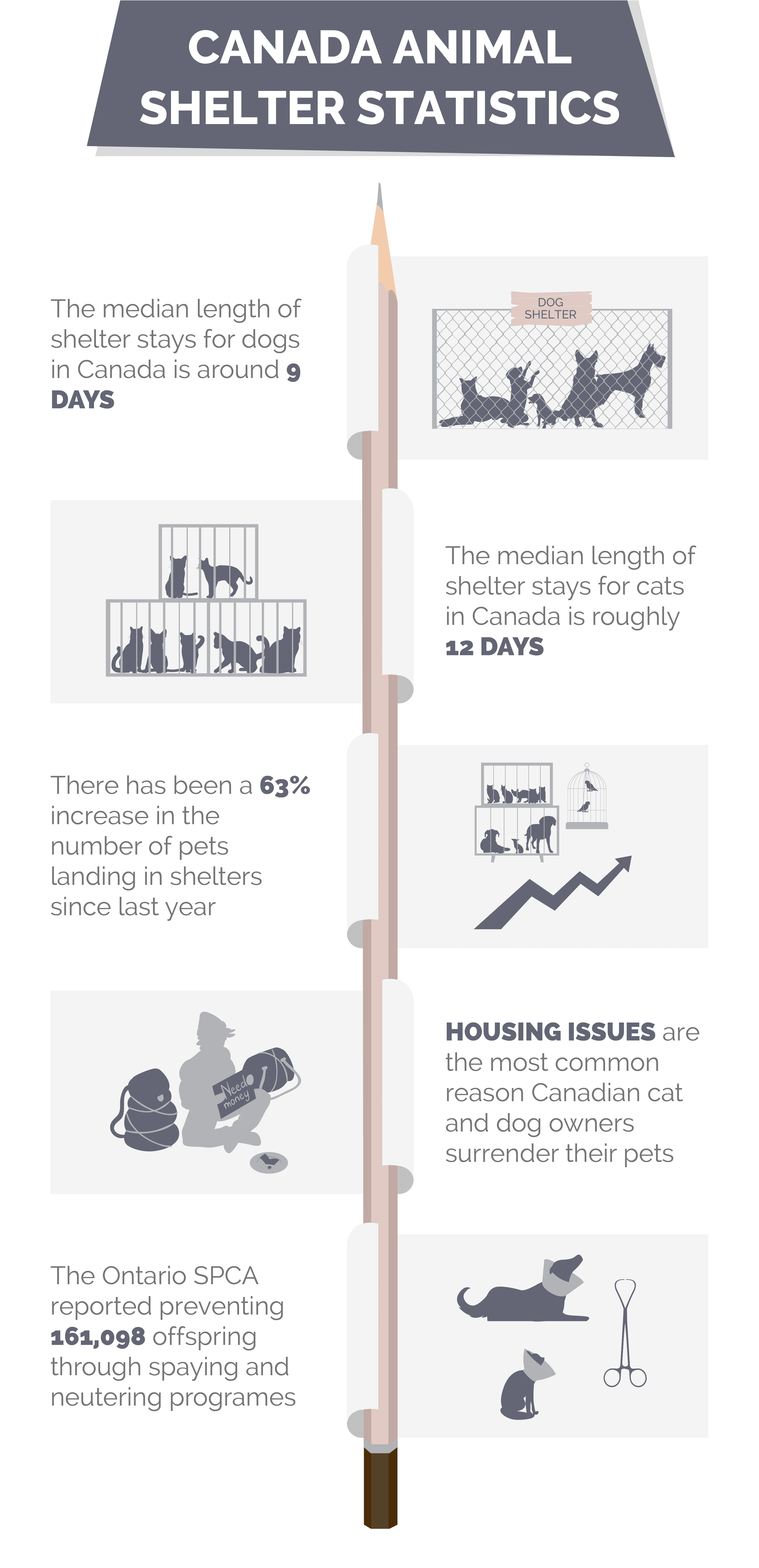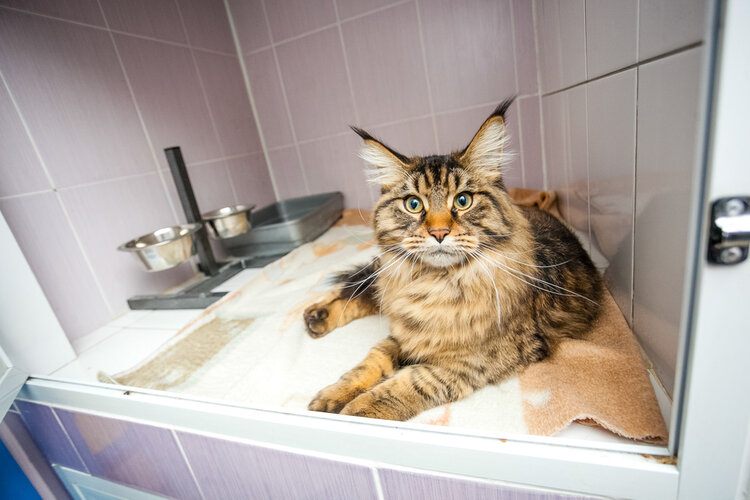14 Animal Shelter Statistics in Canada: Facts to Know in 2024
Updated on

Click to Skip Ahead
Note: This article’s statistics come from third-party sources and do not represent the opinions of this website.
Canadian animal shelters are notorious for their low rates of euthanasia and their high success rate with adoptions. American Humane estimates that 56% of dogs and 71% of cats that enter American animal shelters are euthanized. According to a study from the Canadian Veterinary Journal, just 19% of dogs and 40% of cats were euthanized in Canadian shelters.
If these facts are shocking, you’ll want to keep reading. We’ve compiled a list of 14 other surprising Canadian animal shelter statistics that you should know
The 14 Animal Shelter Statistics in Canada
- In 2020, a historically high number of stray animals were returned to their owners.
- The median length of shelter stays for dogs was just nine days in 2020.
- The median length of shelter stays for cats was just 12 days in 2020
- There was a 25% decrease in cat intakes throughout 2020.
- There was a 28% decrease in canine intakes throughout 2020.
- In 2020, 70% of cats taken into shelters were adopted.
- 14% of shelter cats were euthanized during 2020.
- 18% of current pet owners adopted a pet during the pandemic.
- There were 58,793 cats admitted to animal shelters in Canada in 2020.
- In 2020, there were 20,239 dogs admitted to animal shelters in Canada
- 64% of people believe there is a homeless cat overpopulation crisis in their municipality
- Approximately 400 kittens are born every day on Toronto streets during the spring and summer.
- Housing issues are the most common reason Canadian cat and dog owners surrender their pets.
- The Ontario SPCA reported preventing 161,098 offspring through spaying and neutering programming.

Pandemic Trends
1. In 2020, a historically high number of stray animals were returned to their owners.
(Humane Canada)
The year 2020 proved to be an unprecedented year for stray cats and dogs in Canada. Reports state that 80% of stray dogs were reclaimed by their owners, while 17% of stray cats were returned to theirs. These percentages are up from 2019 when just 28% of dogs and 5% of cats were reclaimed by their owners.

2. The median length of shelter stays for dogs was just nine days in 2020.
(Humane Canada)
In 2020, the median length of stay for dogs in shelters was just nine days. This is down from the median length of 12 days for dogs in 2019. This may be due to the fact that shelter capacity in use was low during the pandemic as many shelters increased foster programming so that more animals than usual were housed outside of shelters.
3. The median length of shelter stays for cats was just 12 days in 2020
(Humane Canada)
In 2020, the median length of stay for cats was just 12 days compared to 15 days in 2019. Again, this may be due in part to the unusually large number of animals that shelters had to place in foster care during the pandemic.
4. There was a 25% decrease in cat intakes throughout 2020.
(Humane Canada)
In 2019, Canadian shelters took in over 78,000 cats. During 2020, however, shelter intake was down 25% compared to the previous year. The proportion of sources of intake remained consistent with previous years, however, with 48% of cats coming to shelters as strays and 35% being surrendered by owners.
5. There was a 28% decrease in canine intakes throughout 2020.
(Humane Canada)
Throughout 2019, Canadian shelters took in nearly 28,000 dogs. In 2020, the shelter intake was reduced by 28% compared to the previous year. As with cats, the proportion of sources of intake remained relatively similar to 2019, with 38% of canine intakes coming in as strays and 34% being surrendered by their owners.

6. In 2020, 70% of cats taken into shelters were adopted.
(Humane Canada) (The Suburban)
The number of cats that were adopted throughout 2020 was the highest ever observed, with nearly 70% of cats taken into Canadian shelters being adopted out. In 2019, 60% of cats were adopted.
7. 14% of shelter cats were euthanized during 2020.
(Humane Canada)
In 2008, over 50% of Canadian shelter cats were euthanized with numbers steadily decreasing since. Then, 2020 saw historically low rates of euthanasia, with just 14% of shelter cats being euthanized. This is just slightly lower than reports from 2019, but when compared to previous years, it’s clear that the number of cats being euthanized in Canadian shelters is on a huge downtrend.
8. 18% of current pet owners adopted a pet during the pandemic.
(Narrative Research)
The COVID-19 pandemic caused a significant increase in pet ownership throughout Canada. Around 18% of pet owners have adopted a new pet since the beginning of the pandemic in March of 2020. Canadians between the ages of 18 and 24 are the most likely demographic to have obtained a pet during the pandemic at 38%, while Baby Boomers are the least likely to have welcomed a new pet into their home at just 9%.
9. There were 58,793 cats admitted to animal shelters in Canada in 2020.
(Humane Canada)
In 2020, animal shelters across Canada took in 58,793 cats. In 2019, shelters took in 78,462. In 2018, the number was slightly higher at 81,602. When looking at the number of admitted cats to animal shelters throughout the years, 2020 saw the lowest number of admissions since 1995.
10. In 2020, there were 20,239 dogs admitted to animal shelters in Canada
(Humane Canada)
The year 2020 saw a historically low number of dog admissions to animal shelters throughout Canada. There were just 20,239 admissions in 2020. Meanwhile, in 2019, there were 27,945, and in 2018, the number was even higher at 29,955. In contrast, 2020 had the lowest number of dog admissions since recording began in 1993.
Homeless Pets
11. 64% of people believe there is a homeless cat overpopulation crisis in their municipality
(Canadian Federation of Humane Societies)
A 2017 survey amongst SPCAs, municipalities, veterinarians, pet rescues, humane societies, and Trap-Neuter-Return (TNR) groups showed that 64% of respondents believe there is a cat overpopulation crisis. The survey is further broken down to show what percentage of each group believes there is a problem. About 95% of TNR groups, 89% of rescues, and 88% of humane societies report cat overpopulation as a serious problem, while just 33% of municipalities perceive there to be a problem.

12. Approximately 400 kittens are born every day on Toronto streets during the spring and summer.
(Animal Alliance of Canada)
Estimates suggest that there could be around 100,000 homeless cats on the streets of Toronto right now. These cats will inevitably mate, causing around 400 kittens to be born on Toronto streets every single day during the warmer months of the year. Cats are very efficient at reproducing, and kittens as young as 5 months are capable of becoming pregnant and can become pregnant again almost immediately after they’ve given birth.
13. Housing issues are the most common reason Canadian cat and dog owners surrender their pets.
(Canadian Federation of Humane Societies)
According to a 2016 study from Humane Canada, housing issues are the top reason why owners surrender their cats and dogs, accounting for 29%. Housing issues include moving, landlord issues, or strata concerns. The next most common reasons are that their pets take up too much time or responsibility (17%) and financial concerns (15%).
14. The Ontario SPCA reported preventing 161,098 offspring through spaying and neutering programming.
(Ontario SPCA)
In 2021, the Ontario SPCA spayed 482 female dogs and neutered 551 male dogs. They spayed 1,166 female cats and neutered 969 male cats. Almost 170 feral cats were spayed, and 131 feral cats were neutered. The SPCA also spayed two rabbits and neutered four. These spaying and neutering procedures prevent an estimated 161,098 offspring from being born.

Frequently Asked Questions
1. How many shelters and humane societies are there in Canada?
According to Humane Canada, there were 174 shelters operated by humane societies and SPCAs throughout Canada in 2020. Statistics for 2021 and 2022 were not yet available at the time of writing.
There are also 125 humane societies and SPCAs throughout the country with approximately 26,000 volunteers at any given time. To be even more specific, there are 57 humane societies and 68 SPCAs in Canada. These organizations spend an estimated $118.4 million every year sheltering hundreds of thousands of animals.
Ontario has the most humane societies and SPCAs with a total of 34, while Alberta comes in second place with 19.
(Humane Canada)
2. What is the Trap-Neuter-Return (TNR) program?
Trap-Neuter-Return is a humane approach to addressing growing homeless cat populations. It not only improves the lives of cats on the streets, but it stops breeding cycles and keeps communities happier.
Cities that have TNR programs in place will humanely trap cats and bring them to a veterinarian for spaying or neutering. These cats will also often receive vaccinations at this time and will be “ear-tipped” to signify that they’ve been neutered or spayed and vaccinated. Ear tipping is a surgical procedure where one-quarter of a cat’s left ear will be removed.
TNR replaces the need for “catch and kill” protocols to try and control the feral cat population.
(Alley Cat Allies)

3. Do Canadian animal shelters euthanize animals?
Canadian shelters will sometimes euthanize animals, but there are specific circumstances that must be present to warrant the euthanasia. A study that included 67 animal shelters across Canada showed that of those 67 establishments, just seven stated that they didn’t euthanize animals at all at their premises. Twenty said they perform euthanasia on-site while 24 sent the animals to local veterinary clinics for the procedure.
There are very specific guidelines that must be followed when euthanizing an animal in a shelter. The Guidelines for Standards of Care in Animal Shelters from the Canadian Advisory Council on National Shelter Standards state that the following guidelines must be met:
- A veterinarian with the proper training for the procedure must be consulted.
- The animal must be treated with respect.
- The euthanasia method must quickly induce loss of consciousness and be reliable and irreversible.
- The death must be as free from pain, anxiety, and distress as possible.
- The animal in question must be scanned multiple times for identification chips.
- An assessment needs to take place to ensure the appropriate drug dose, needle size, and restraint method are used.
(The Canadian Veterinary Journal) (Canadian Advisory Council on National Shelter Standards)
4. What are “no-kill” facilities?
A true no-kill facility is one where the animals admitted to it are kept alive no matter the cost. Absolutely no animal that enters the facility with face euthanasia regardless of their health status or temperament.
While no-kill facilities seem great on paper, there are some downfalls. These facilities do not acknowledge that emotional suffering can be just as damaging to animals as it is to humans. An animal who is suffering emotionally or behaviorally can be in as much distress as one who’s hurting physically. These facilities will adopt out animals with aggression problems even though they may be a danger to their adoptive families.
Even PETA doesn’t agree with the sentiment behind no-kill facilitates. They state that these shelters are left with two options once they reach capacity: turn away more animals than they’re able to take in or take in animals above their capacity limits and warehouse them in substandard living conditions.
(Ontario SPCA) (PETA)

Final Thoughts
While it seems like the tides are turning for Canadian animal shelters as they’re adopting out more and euthanizing less, only time will tell if these numbers continue to sway in the favor of the shelter animals. The pandemic caused a lot of people to have a whole lot more spare time than they’re used to which led them to adopt new pets in record numbers. It will be interesting to see what the statistics look like for Canadian animal shelters for this year and beyond.
Related Read:
Featured Image Credit: Africa Studio, Shutterstock












